[ad_1]
What is keyword search volume?
Keyword search volume refers to a number of searches for a given keyword during a selected time frame (usually a month). In most keyword research tools, the number of searches is an average value based on the last 12 months.

Why should you care about search volumes?
The search volume of a keyword is one of the most important metrics to consider when doing keyword research. Knowing the search volumes of the keywords you want to target can help you:
- prioritize the content topics
- see the search trend of the keyword
- estimate the traffic potential
To put it very simply: You may think you have a perfect keyword, but if nobody really searches for that keyword, you won’t get any visitors to your website even if you rank for it.
How to get the search volume of a keyword?
To get the search volume data, you need to use a keyword research tool.
1) Free tools
Some free keyword tools have search volume data, but they are usually very limited in their use.
For a long time, Google Keyword Planner was the obvious free choice for many SEOs, although it’s always been a keyword tool for PPC campaigns.
The problem is the tool no longer shows the exact numbers unless you spend money on PPC campaigns.
So if you open Google Keyword Planner and enter the seed keyword “best running shoes”, it will show you the ranges like “10K – 100K”, which can actually be 11,000 but also 99,000.
Not very helpful.
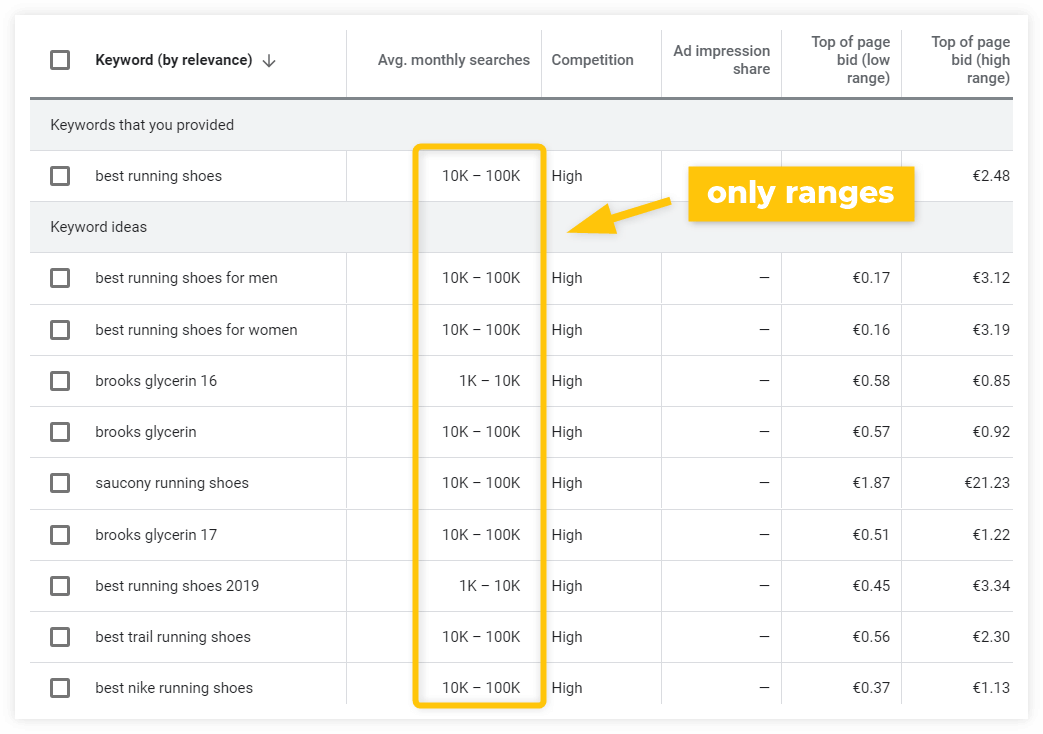
Another minor problem is the so-called keyword clustering. It is a common technique when creating PPC ad groups that contain similar keywords and it leads to better organization, higher quality score and CTR.
However, for SEO purposes, it’s almost always better if you “cluster” your keywords manually. Relying on a PPC keyword tool to do it for you, without knowing what keywords were actually grouped together, is not the best idea.
So Google Keyword Planner is a great choice if you’re running a PPC campaign. But it’s not sufficient for the SEO purposes.
Check our list of 9 best free keyword research tools for more options.
2) Professional tools
If you’re serious about SEO, getting a quality keyword tool with reliable data is a must.
A great advantage of a professional keyword research tool is that besides search volume values, it provides many other useful metrics and data you’ll need when evaluating the keywords. These include:
- keyword difficulty metric
- the search trends
- CPC and PPC values
- SERP results with details about your competitors
Here’s what the search volume column looks like in KWFinder:
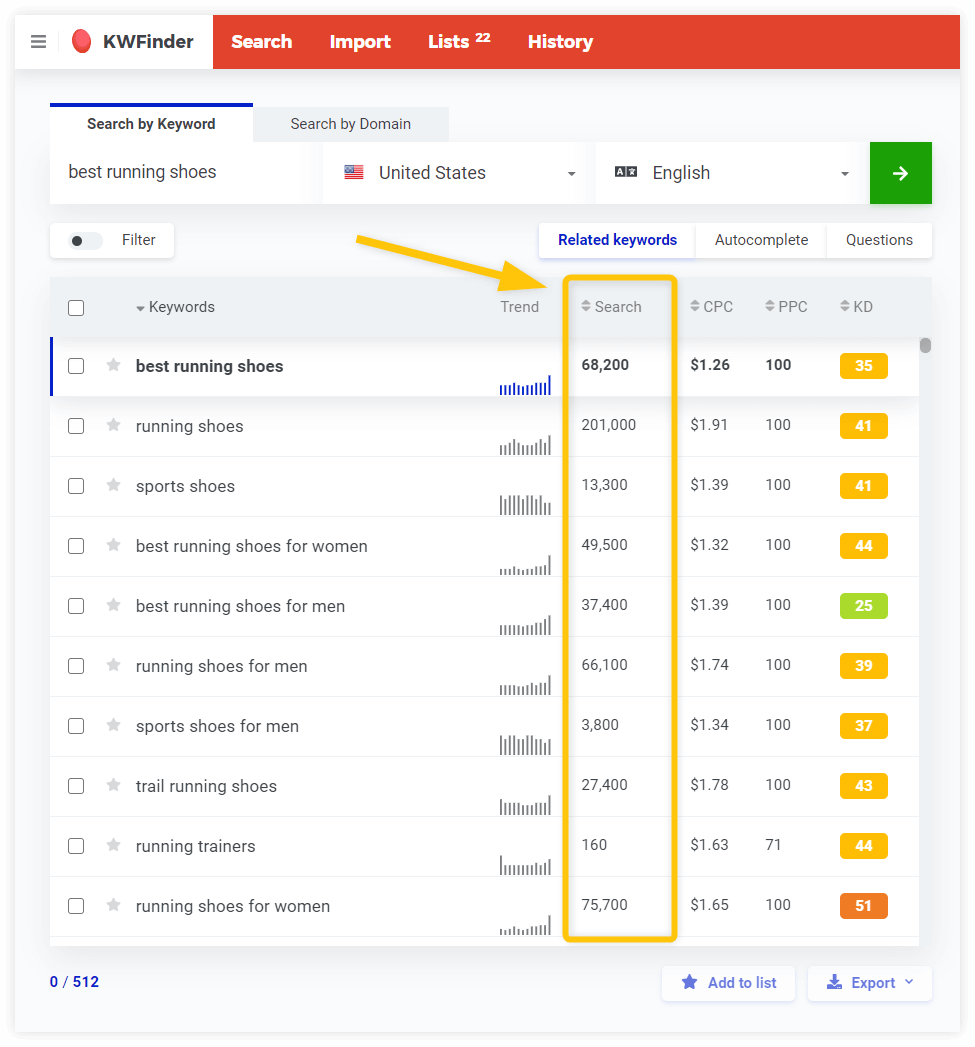
Now let’s say you already have a list of keywords and you need to find out their search volume.
You can import your keywords to the tool – either by uploading a list or typing in the keywords one by one.

The tool will spit out your keywords with exact search volume data for each of them:
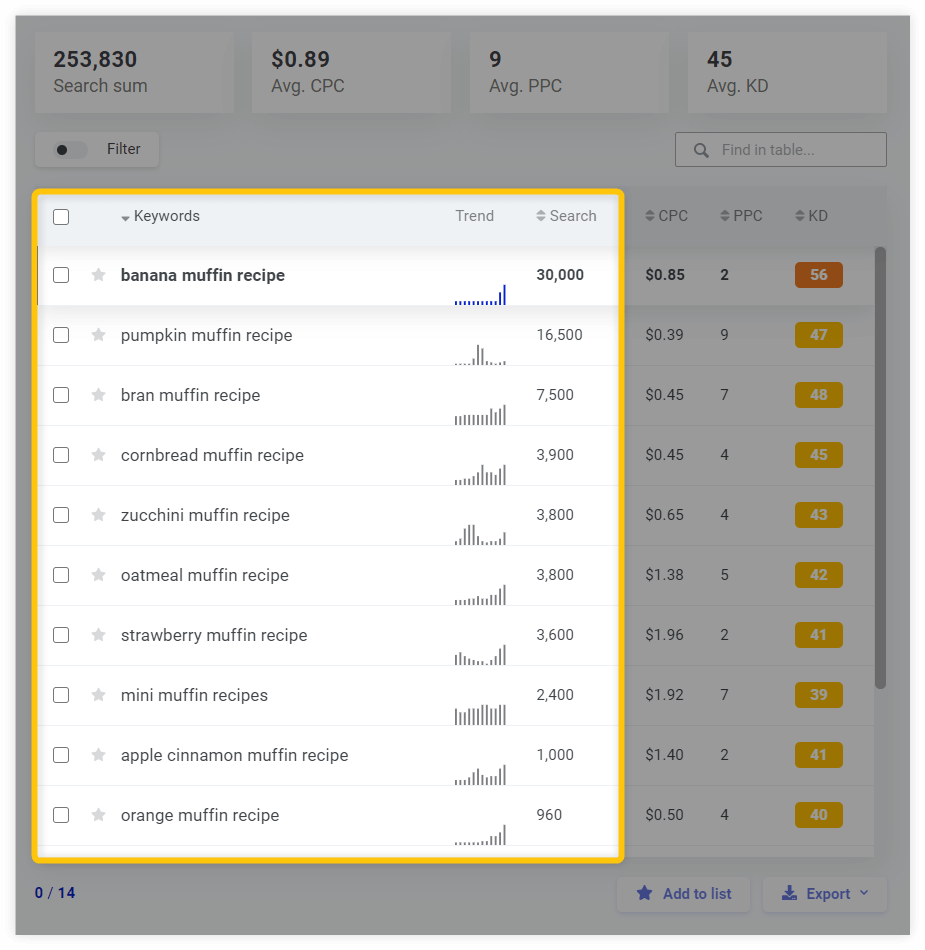
Where do keyword search volume data come from?
In general, there are two main sources of search volume used in the tools:
- Google data – Google database is still one of the most reliable sources of search volume data, although it may need to be post-processed in order to be precise, as Google tends to cluster similar keywords and show search volume for the whole group instead of single keywords.
- Clickstream data – Clickstream search volume data is collected via browser extensions, plugins and other applications that you install on your computer. The data is aggregated and sold to be used further. Tools like Moz or Ahrefs display search volumes based on the clickstream data.
Google data vs. clickstream data
Both Google data and clickstream data have their pros and cons.
The biggest downside of Google search volumes is that no one really knows how they gather the data. Another important factor is that Google groups topically similar keywords, especially long-tail terms so the data needs to be post-processed to show more precise results for certain keywords.
On the other hand, Google owns amazing data sources, it is by far the biggest database out there.
When it comes to clickstream data downsides, the most significant is that they offer only a small fragment of data when compared to Google. So the search volume estimates are made from a much smaller sample of keywords and may be less accurate.
Here’s a quick sample of the differences between the search volume data from Google Keyword Planner and 4 other popular commercial keyword tools:
| GKP | KWFinder | Ahrefs | SEMRush | Moz | |
| travel tips | 5,400 | 5,400 | 5,900 | 5,400 | 1,7 – 2,9K |
| how to write better | 1,900 | 1,700 | 3,100 | 1,600 | 850 – 1,7K |
| banana muffin recipe | 27,100 | 30,000 | 9,000 | 22,200 | 6,5 – 9,3K |
| aquascaping | 22,200 | 21,500 | 7,100 | 22,200 | 4,3 – 6,5K |
| microscope for kids | 6,600 | 6,200 | 1,300 | 5,400 | 850 – 1,7K |
As you can see, the numbers differ from tool to tool.
While most keyword research tools use Google Keyword Planner as their primary source of keyword search volume data, the search volume values differ. The reason is that they use various additional sources (like clickstream data) and post-process the keywords to avoid Google’s clustering and show more precise results.
If the same keyword has the search volume 10,000 in one tool and 11,500 in another, it’s perfectly fine.
Don’t become a slave of search volumes. Compare the data across the tools, but focus on the trends and correlation within one tool instead of panicking about small discrepancies between various tools.
What is a good search volume?
The short answer would be – the higher the search volume, the better. A high search volume means the term is popular and if you rank for it, you’ll get more traffic from Google.
But you should also consider other things (like keyword relevance or keyword difficulty) to evaluate whether it is a good idea to target the keyword.
Besides the actual popularity of the keyword, the search volume depends on other things, namely:
- Your niche. If you run a blog about knitting, you’ll hardly find relevant keywords with millions of searches, since your main keyword – knitting – has “only” 216,000 searches per month.
- The selected location. The more you narrow down the location in your search, the fewer monthly searches the keyword has. There may be regional differences too.
- How specific the keyword is. Broader keywords like “weight loss” (480,000) will always have higher search volume than specific phrases like “disadvantages of keto diet” (1,300).
Types of keywords based on their search volume
Traditionally, we distinguish between 3 categories of keywords based on how many searches per month they have:
- Fat-head keywords – the big, broad keywords with millions of searches like “shoes” or “marketing”
- The “chunky middle” – more detailed keywords like “best running shoes” or “marketing techniques” with (tens of) thousands of searches
- Long-tail keywords – longer keywords with specific search intent having lower search volume but usually higher engagement. Long-tail keywords account for about 70% of all web searches.
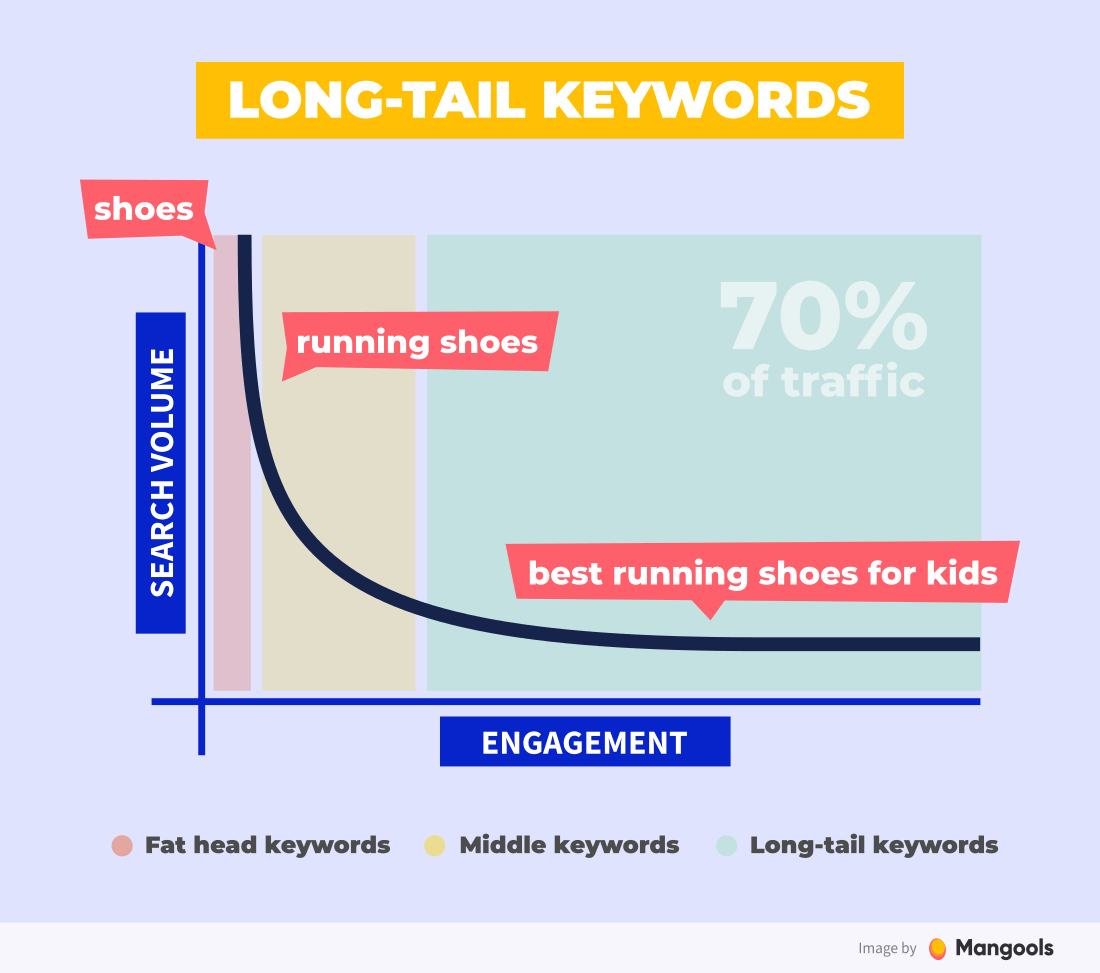
However, this categorization is quite vague and the length of the keyword and the search volume do not always correlate. You can have a long-tail keyword with thousands of searches as well as an unpopular single-word keyword with just a couple of searches per month.
As we’ve already mentioned, it would be a mistake to base the keyword research solely on search volume. Yes, it is an important value, but not the only one you should focus on.
Besides the search volume, you should always look at the other two aspects:
- Keyword difficulty – will you be able to rank for the keyword or is it too competitive for your little website?
- Keyword relevance – is the keyword relevant to your website and the type of content you plan to publish? (the best way to find out is through a detailed SERP analysis)
Together with search volume, you can think of these 3 aspects as 3 legs of a tripod. All three of them are equally important and if you fail at one of them, your tripod will fall.
Historical search volumes, trends and seasonality
Most of the tools display the average search volume for the last 12 months. However, it may be useful to see how the popularity of the keyword changed over long periods of time too.
For this, you’ll need a tool with a graph of historical search volume data. Here’s an example from KWFinder for the keyword “home gym”:
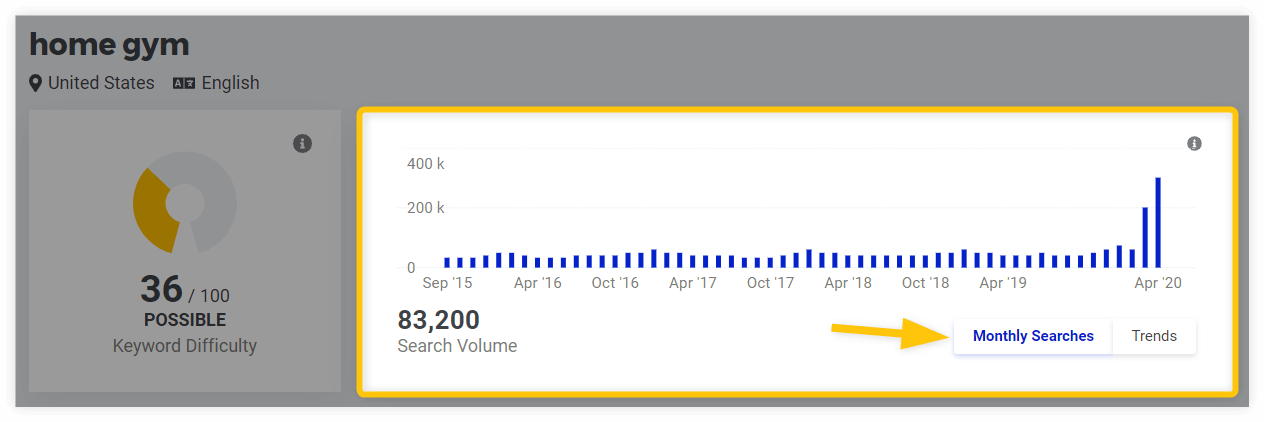
We can clearly see that there was a sudden spike in interest in March and April 2020 due to the coronavirus pandemic and many people staying at home.
It can help you spot how many times the keyword was searched in the last couple of years.
Of course, the further you can look back, the better idea you’ll get about the popularity of the search term. This is when the search trends graphs come in handy.
Here’s the search trend for the keyword “SEO”:

Although you don’t see exact search volume values in this case, you can see the change in interest based on the data from Google Trends for a much longer period of time (in this case, from 2004 until the present).
This can be very useful when looking for a new niche or a topic. In general, the number of internet users is growing over time, so a declining search interest is not a good sign.
Another thing that’s good to notice in advance is the seasonality of the keywords.
Don’t focus only on the average search volume value (based on the last 12 months) but also on the highest and lowest search volume values during the year. They can differ dramatically and you should take that into account when evaluating the keyword.
Here’s an example for the keyword “ski equipment”:
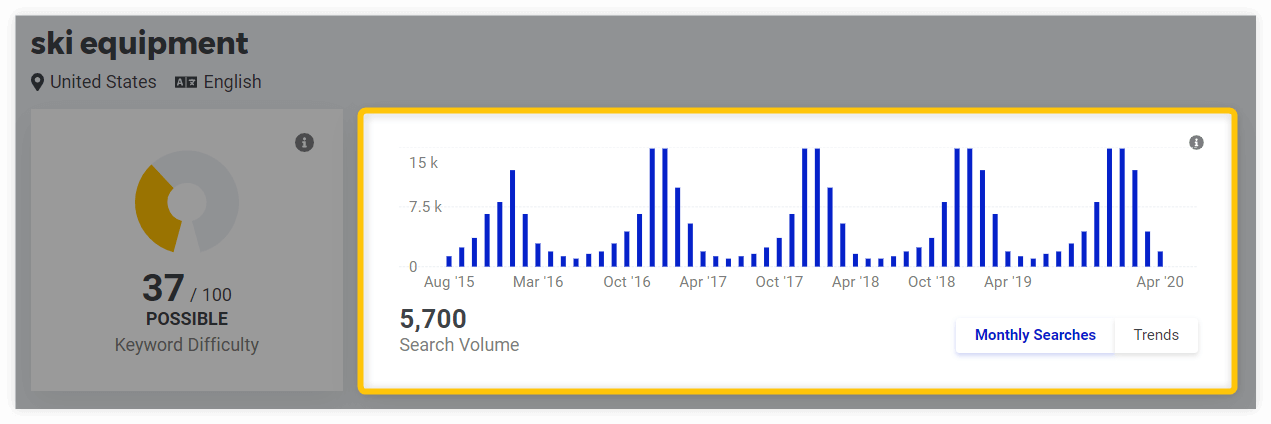
Notice that the average monthly search volume is 5,700, but the number of searches varies throughout the year: while there are 14,800 searches in December and January, it only has a search volume of 1,000 in June.
You can use Google Trends to identify the popularity and seasonality with a lot of useful information such as interest by subregion, various time frames or search types.
Key takeaways
- Keyword search volume is one of the most important things to consider when evaluating the keywords in the keyword research process.
- However, it’s not the only one and you should pay attention to other keyword factors like difficulty and relevancy.
- To get the keyword search volume data is to use a quality keyword research tool (like KWFinder).
- The values will differ in various tools based on their data source and post-processing techniques. It is normal.
- You can compare the values between various tools, but focus on the trends and correlations rather than differences.
- Search volume depends on various things – always consider your niche, the location and how specific your keyword is.
- It is always good to look at the search volume from a wider perspective – through historical data, search trends and potential seasonality.
[ad_2]
